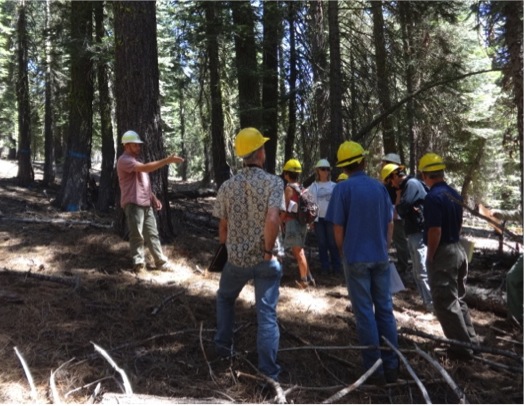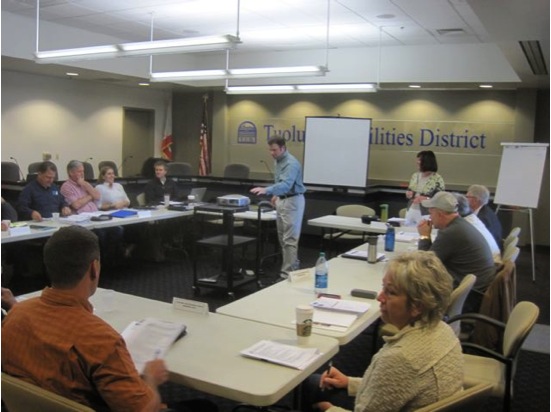 During most of the years that CSERC has played a key role in forest and water issues of the region, local pro-use interests clearly controlled the attention of federal and state decision-makers. The limited number of environmental victories came either from lawsuits or through CSERC’s intensive field monitoring and on-the-ground expertise about rare wildlife species, roadless areas, old growth forest stands, or the status of water quality in rivers and streams. Seldom did all sides sit down together and respectfully discuss their differing views about projects, issues, and desired outcomes.Whenever plans or projects were unveiled, timber interests, cattlemen, motorized recreation groups, and environmentalists each submitted comments. CSERC staff consistently provided the most detailed and the most site specific comments, but all parties attempted to shape projects and policies to favor their agendas. That approach changed for water and watershed issues nearly a decade ago when the State dangled the carrot of giant grants that were only available if broadly diverse interests joined together to do collaborative planning. The resulting Tuolumne-Stanislaus Intergrated Regional Water Management Authority is exactly what the State desired. Water agencies, county representatives, conservation groups, and other interests meet monthly and periodically apply for huge state grants.Two local forest collaborative groups have also formed in our region, and both can boast highly diverse membership. Yosemite Stanislaus Solutions (YSS) deals mostly with national forest projects and plans across the southern half of the Stanislaus Forest. The Amador Calaveras Consensus Group (ACCG) focuses on the northern Stanislaus Forest and southern portion of the Eldorado Forest. Each of the three total collaborative groups has excellent facilitiation, dedicated member representatives, and highly devoted participants from the USFS and from water agencies. Discussions are almost always respectful. Lots of sharing takes place, and all three groups have gained some significant funding. It seems progressive.
During most of the years that CSERC has played a key role in forest and water issues of the region, local pro-use interests clearly controlled the attention of federal and state decision-makers. The limited number of environmental victories came either from lawsuits or through CSERC’s intensive field monitoring and on-the-ground expertise about rare wildlife species, roadless areas, old growth forest stands, or the status of water quality in rivers and streams. Seldom did all sides sit down together and respectfully discuss their differing views about projects, issues, and desired outcomes.Whenever plans or projects were unveiled, timber interests, cattlemen, motorized recreation groups, and environmentalists each submitted comments. CSERC staff consistently provided the most detailed and the most site specific comments, but all parties attempted to shape projects and policies to favor their agendas. That approach changed for water and watershed issues nearly a decade ago when the State dangled the carrot of giant grants that were only available if broadly diverse interests joined together to do collaborative planning. The resulting Tuolumne-Stanislaus Intergrated Regional Water Management Authority is exactly what the State desired. Water agencies, county representatives, conservation groups, and other interests meet monthly and periodically apply for huge state grants.Two local forest collaborative groups have also formed in our region, and both can boast highly diverse membership. Yosemite Stanislaus Solutions (YSS) deals mostly with national forest projects and plans across the southern half of the Stanislaus Forest. The Amador Calaveras Consensus Group (ACCG) focuses on the northern Stanislaus Forest and southern portion of the Eldorado Forest. Each of the three total collaborative groups has excellent facilitiation, dedicated member representatives, and highly devoted participants from the USFS and from water agencies. Discussions are almost always respectful. Lots of sharing takes place, and all three groups have gained some significant funding. It seems progressive.
 What is not clear to CSERC, however, is whether our investment of so much time and energy in each of these collaboratives actually translates into the agencies doing something truly different than if no collaborative group existed. Despite lots of nice attention for the collaboratives groups from politicians, the media, and agency officials, it is not clear that state or federal actions for projects in our local region have changed as a result. Instead, even when all parties (the timber industry, local politicians, environmental groups, and businesses) completely agree on the need for certain actions to be done, the Forest Service in particular appears to move forward at the same pace and scale of projects as previously. And when it comes to the millions of dollars awarded by the State to the Tuolumne-Stanislaus IRWMA, the majority of those dollars has gone to projects that water agencies requested for their water systems or for surviving the drought. Actual benefits to the environmental are limited.
What is not clear to CSERC, however, is whether our investment of so much time and energy in each of these collaboratives actually translates into the agencies doing something truly different than if no collaborative group existed. Despite lots of nice attention for the collaboratives groups from politicians, the media, and agency officials, it is not clear that state or federal actions for projects in our local region have changed as a result. Instead, even when all parties (the timber industry, local politicians, environmental groups, and businesses) completely agree on the need for certain actions to be done, the Forest Service in particular appears to move forward at the same pace and scale of projects as previously. And when it comes to the millions of dollars awarded by the State to the Tuolumne-Stanislaus IRWMA, the majority of those dollars has gone to projects that water agencies requested for their water systems or for surviving the drought. Actual benefits to the environmental are limited.
At the moment, the Forest Service and the State can tout the region’s collaborative processes as prime opportunities for dialogue. But as CSERC pours high amounts of staff time into engaging intensely in these three processes (and one new additional state level river management process), it remains to be seen whether all the harmonious sharing and years of meetings will actually produce results that wouldn’t likely happen otherwise.

